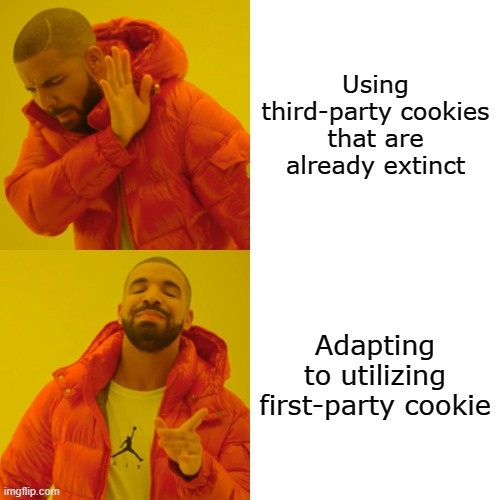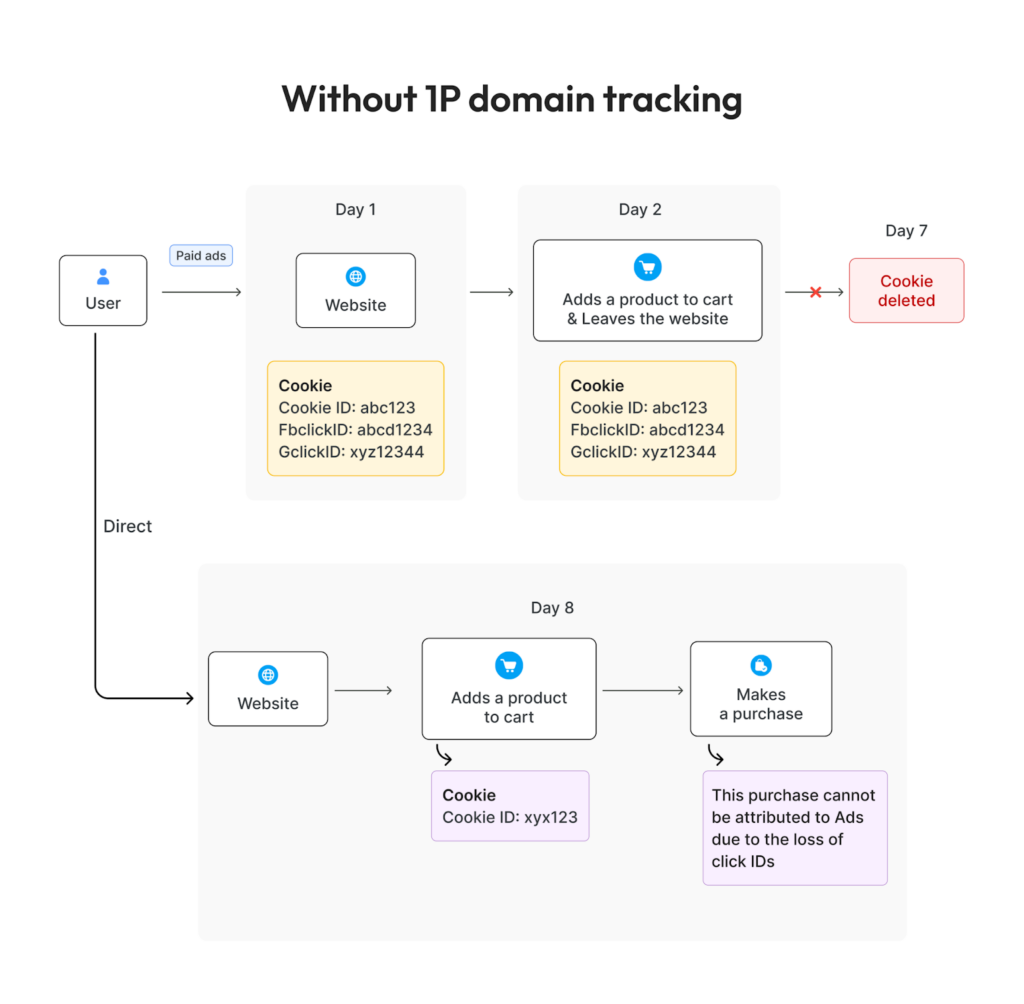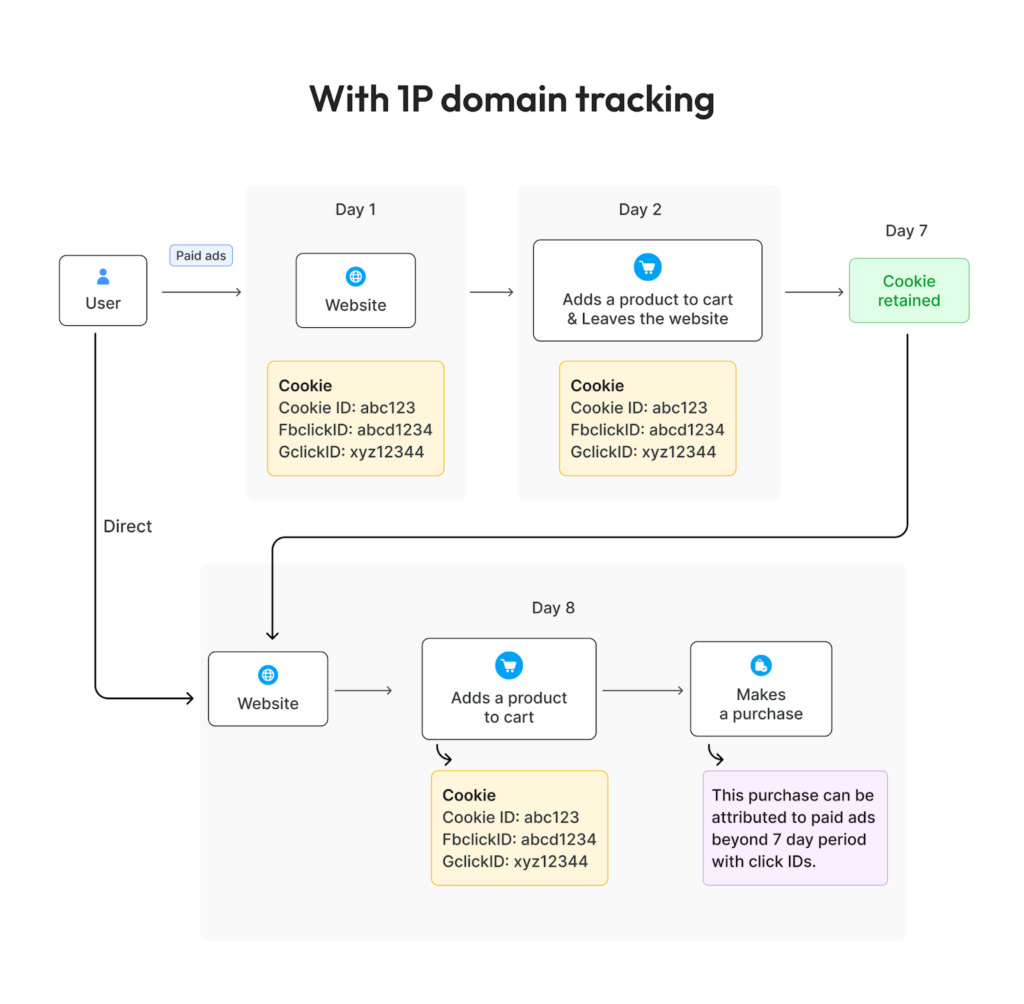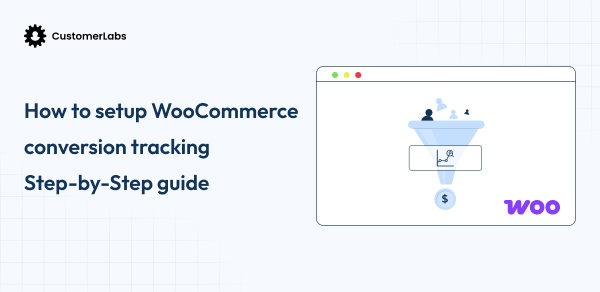
Third-party cookies are dead and long gone. Well almost in Google Chrome…
So forget what you know about traditional third-party cookie-based tracking. Platforms like Safari and Firefox are tightening their privacy belts, making it harder to track user behavior over time. Because, third-party cookies face a ticking clock, with many browsers wiping them clean after just seven days.
Now, imagine the impact on your marketing campaigns. How can you accurately measure conversions or retarget effectively when your data keeps disappearing?
It’s a challenge that demands a new approach, and that’s where server-side 1P domain tracking steps in.
In this blog, we’re not just exploring a technical solution; we’re unlocking the potential for your WooCommerce store to thrive in a third-party cookie-constrained world. By understanding and implementing 1P domain tracking on your server, you’ll regain control over a better attribution of your WooCommerce store.
Understanding 1P domain tracking
First, let’s get a clear picture of first-party cookies.
Whenever a user visits your WooCommerce store, first-party cookies are the cookies that are created and managed by your domain.
The real game-changer? Ad blockers typically block third-party cookies but recognize and allow first-party cookies since your domain sets them.
Privacy-centric browsers like Safari and Firefox automatically remove third-party cookies after 7 days. However, first-party cookies have a longer lifespan and retain more data, offering richer insights into your customer behavior.
The process of implementing these first-party cookies on your website through server-side tracking is known as server-side 1P domain tracking. By setting this up, you can track user behavior using first-party cookies from your own domain, ensuring compliance with data privacy regulations.
Server-side 1P domain tracking gives you the upper hand in enhancing your ad campaigns since you get the complete journey of customer behavior.
Learning how 1P domain tracking on the server side works
Before understanding how 1P domain tracking works on the server side, let’s take a quick look at traditional client-side cookie tracking.
Typically, on client-side cookie tracking, client-side cookies are set by third-party scripts or influenced by external domains. This makes the cookies easy targets for privacy-focused browsers like Safari and Firefox and ad blockers, leading to inconsistent tracking and data loss.
Here’s a brief pictorial representation of what happens without a 1P cookie:

Now, let’s move on to 1P domain tracking on the server side where the entire process is handled on the server side.
When a user lands on your WooCommerce store, the server sets cookies directly from your first-party domain, such as www.yourwebsite.com, or subdomains like 1p.yourwebsite.com. These cookies are instantly recognized as first-party by browsers and ad blockers, ensuring they remain unblocked and secure.
Here’s a brief pictorial representation of what happens with a 1P cookie:

Getting more deeper
Server-side 1P domain tracking makes use of your subdomain whenever a user lands on your website.
These subdomains are not mapped to external domains via CNAME. So browsers like Safari and Firefox treat these cookies as first-party and keep them intact for longer periods, even beyond the typical seven-day limit.
Imagine a user revisits your site after several days. Thanks to server-side 1P domain tracking, the cookies set by your domain ensure they are identified as the same user and will be mapped with the existing user details. If they purchase after 7 days, their conversion will be accurately attributed to ad platforms.
Server-side 1P domain tracking enables seamless and continuous tracking, providing a complete view of the user journey and interactions with your WooCommerce site.
The significance of 1P server-side cookies
Accurate conversion attribution
Traditional client-side cookies are often short-lived, leading to inaccurate attribution.
Imagine a user clicks on a paid ad, and visits your WooCommerce store, but doesn’t make a purchase immediately. If the user returns after the traditional cookie has expired, the conversion might be incorrectly attributed to a direct visit instead of the original ad. This misattribution can make you believe your ad campaign isn’t performing well.
With 1P domain server-side tracking, cookies are managed on the server, ensuring that user interaction data is retained for longer periods.
This means that even if a user returns after several days, the conversion is accurately attributed to the correct ad.
By implementing server-side 1P cookies, you ensure accurate attribution, providing clear insights into the effectiveness of your ad campaigns.
Enhanced identity resolution
Server-side tracking with 1P domain cookies, especially with CustomerLabs through Stitcher 2.0—an advanced identity graph technology, takes identity resolution to the next level.
It extends the lifespan of your cookies, which leads to effectively unifying user profiles across multiple sessions and touchpoints. This creates a comprehensive 360-degree view of your customers, enabling you to deliver highly personalized experiences across various ad platforms.
Being able to track a user from their first interaction to their last, by collecting and unifying external IDs and click IDs along the way ensures the right acquisition channel gets the credit, avoiding the costs due to misattribution.
Bonus benefit—With a clear understanding of how many touchpoints lead to a conversion, you can optimize your marketing strategies and improve ROI.
The steps to set up server-side 1P domain tracking in WooCommerce
Here’s how you can implement server-side 1P domain tracking for your WooCommerce store.
First, ensure you have subscribed to the 1P domain tracking add-on in the CustomerLabs app.
Once subscribed, navigate to the settings.
In the settings, locate the 1P domain tracking section and click on “Add Domain.”
Here, you’ll need to enter your naked domain, which means the domain name without any prefixes like HTTP, HTTPS, or www. For example, enter “yourwebsite.com.”
After adding your naked domain, specify a subdomain.
Note that even a “www” prefix can also be a valid subdomain.
You have two options here.
For a smoother setup, it is recommended to choose the “Managed Service.”
This simplifies the process, although you can also opt to use your own Cloudflare account if preferred.
Proceed with the migration process of your DNS provider in your CloudFare.
Click on Verify DNS and you’ll be getting an email. Follow the instructions in the email and your domain will be automatically generating first-party cookies.
Once verified, go back to the CustomerLabs dashboard.
Then, map the nameservers as assigned by Cloudflare to your domain.
Return to your CustomerLabs dashboard and copy the 1P domain tracking code provided.
You’ll need to install this code on your WooCommerce store.
Double-check that the WooCommerce conversion tracking plugin is installed correctly on your store. Ensure all the default events you wish to track are selected.
By following these steps, you’ll have successfully connected your WooCommerce store with CustomerLabs for server-side 1P domain tracking.
Verifying server-side 1P domain tracking for the WooCommerce store
Ensuring that your server-side 1P domain tracking is set up correctly is crucial for accurate data tracking and attribution.
Here’s how you can verify that everything is working as it should for your WooCommerce store:
After setting up 1P domain tracking in CustomerLabs, navigate to the 1P domain tracking dashboard.
Click on Verify DNS.
You should see a status message indicating “Verified.” This means your records have been correctly verified.
If you’re using a CloudFare account, here’s how you can verify:
Open a new browser or use a different browser than the one you used for setup and enter your website URL.
Once your site loads, right-click on the page, and select “Inspect.”
Go to “Network” and enter your CustomerLabs id.
Check whether you have your own domain in the “Request URL”
This confirms that the cookies are being generated by your server, indicating that the server-side 1P domain tracking is active.
The benefits of server-side 1P domain tracking
1. Navigating the data privacy landscape
Server-side 1P domain tracking is a game-changer for WooCommerce stores, especially in an era of stringent data privacy regulations like GDPR and CCPA and the decline of third-party cookies.
As the first-party cookies set by your domain are immune to ad blockers and browser restrictions, it ensures that your data retention is robust and reliable. By providing a clear and uninterrupted view of the customer journey, it enhances accurate attribution, allowing you to efficiently optimize your ad campaigns.
Furthermore, server-side 1P domain tracking aligns seamlessly with evolving privacy standards, offering a sustainable and privacy-compliant pathway that not only safeguards your WooCommerce store from legal pitfalls but also builds trust with your customers.
2. Accurate data collection and conversion tracking inside ad platforms
Server-side 1P domain tracking revolutionizes data accuracy for WooCommerce stores, capturing every user interaction without a hitch. This ensures seamless and comprehensive data collection, crucial for attributing accurate conversion data with ad platforms.
By providing precise conversion attribution, it empowers marketers to optimize their campaigns effectively and gain a crystal-clear view of true performance.
3. Optimizing ad campaigns
With server-side 1P domain tracking, you’re fueling their ad algorithms to be trained effectively with high-quality first-party data. With the algorithms trained on this data, you can optimize the ad campaigns effectively.
This leads to more effective retargeting strategies and increased ad targeting precision, ultimately resulting in overall ad campaign performance.
4. Complete data control
Gain ultimate command over your WooCommerce store’s data with server-side 1P domain tracking!
By managing and retaining customer data internally, you can reduce reliance on third-party sources, enhancing data security and compliance with privacy regulations like GDPR and CCPA.
This means you can ensure that data collection, processing, and utilization are conducted ethically and securely, safeguarding against breaches and unauthorized access.
With complete data control, from collection to utilization, you can optimize ad campaigns with precision and maintain a competitive edge in the data-driven world.
5. Enrich the data
By managing data on your own servers, you can integrate diverse sources such as website interactions, CRM entries, and offline data into a cohesive customer profile.
This 360° view enhances your understanding of customer behavior and enables more accurate audience segmentation for personalized ad campaigns. With the data from across the sources, you’ll have enriched data for each user.
Moreover, enriched data supports advanced analytics and machine learning models, empowering you to predict customer needs effectively and tailor ad strategies accordingly.
With this capability, you can craft compelling customer experiences that drive higher conversion rates and achieve greater customer satisfaction.
6. Retargeting anonymous WooCommerce store visitors
Imagine your WooCommerce store welcoming a stream of visitors, where nearly 98% slip in and out anonymously, leaving no traceable details.
With server-side 1P domain tracking, you can capture data from anonymous visitors who don’t provide identifiable information and retarget them effectively across ad platforms.
By capturing essential data like click IDs, browser IDs, and device IDs(even from users who haven’t logged in or provided contact details) you transform anonymous visitors into potential customers.
This means you can reach out to a significant portion of your visitor base across diverse digital channels that would otherwise remain untapped.
7. High EMQ score
Server-side 1P domain tracking helps you collect data with quality signals. By gathering rich, detailed signals with each user interaction, you enhance the precision of event matching across ad platforms like Meta Ads.
When the signals are matched accurately with the users, it will ultimately lead to a higher event match quality.
8. Higher custom audience match rates
Server-side 1P domain tracking along with CustomerLabs will help you accumulate the user data over time—be it 90 days, 60 days, or beyond.
The entire audience segment data, enriched with data gathered over extended periods, is then seamlessly synced with platforms like Meta Ads, Google Ads, and TikTok.
The result? You experience enhanced custom audience match rates for both anonymous visitors and known users alike.
9. Maximized ad campaign performance
Harnessing server-side 1P domain tracking for your WooCommerce store maximizes ad campaign performance through a wealth of benefits as we saw above.
The outcome? Significantly increased ad campaign effectiveness and improved ROI.
Until now, we have seen all the benefits you get out of server-side 1P domain tracking. But how about we see a real-time example?
Case Study: How CookD slashed their CAC by 45%!
Here’s a case study on how CookD, an innovative e-commerce platform specializing in food recipes, leveraged this advanced tracking technology to enhance its marketing strategies.
By implementing server-side 1P domain tracking through CustomerLabs, they ensured lasting storage of crucial data like FB Click IDs and Google Click IDs, leading to more accurate attribution and an increase in ROAS.
Moreover, by deploying custom conversion events through server-side integration with Meta Ads, CookD optimized for high Average Order Value (AOV) purchases.
Results CookD is witnessing
- Shifted focus from ROAS to controlling CAC & incremental revenue
- Increased ROAS by 35%
- Reduced CAC by 45%
To sum it all up…
By shifting away from traditional third-party cookies and leveraging the expertise of first-party cookies set on your server side, you ensure accurate attribution, enhanced data control, and enriched customer insights.
This approach not only navigates the evolving data privacy landscape but also optimizes your ad campaigns for better performance and higher ROI.
As demonstrated by the success of CookD, server-side 1P domain tracking through CustomerLabs is the secret to the exponential growth of your WooCommerce store having countless benefits such as accurate attribution, enhanced ID resolution, retargeting anonymous visitors, increased EMQ, higher custom audience match rates, and so much more.




